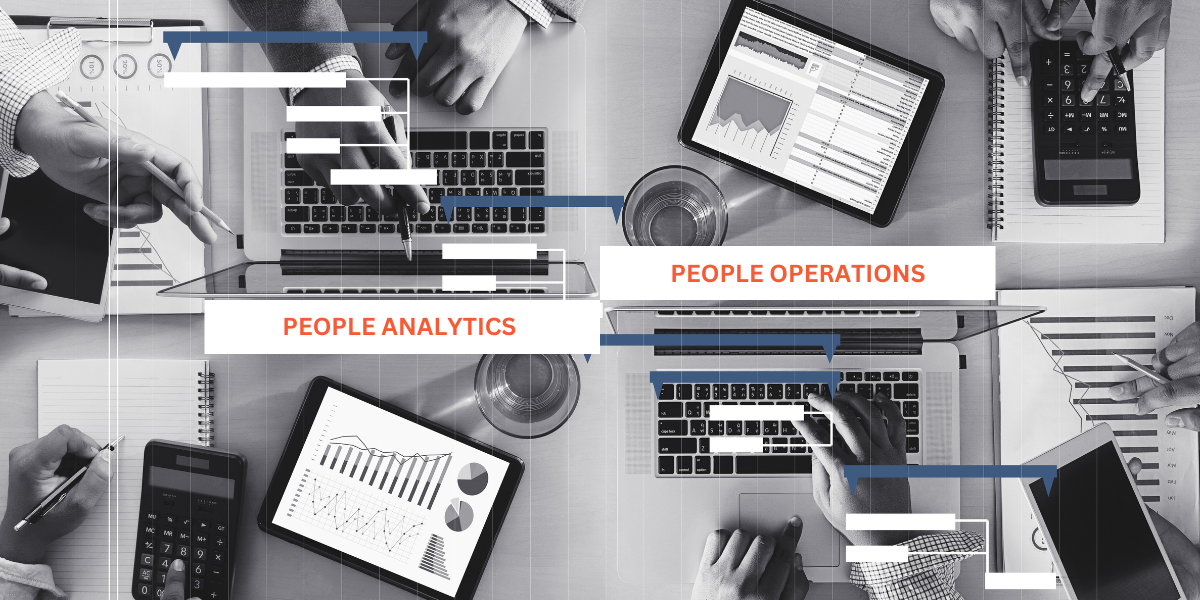Welcome to “Embracing Digital Transformation: The Rise of People Operations in Modern HR”. This article explores the shift to people-centric HR practices, focusing on People Operations and its role in digital transformation.
To help you navigate this evolving landscape, we’ve incorporated two essential self-assessments:
- ‘Assess Your People Management Level’ which evaluates your current people management practices, and;
- ‘Assess Your People Analytics Level’ which gauges your proficiency in using workforce data effectively
Beyond these assessments, we’ll also discuss HR’s pivotal role in digital transformation and illustrate the path to Level 5 – the peak of People Operations maturity. Join us as we delve into the future of HR, and together, let’s unlock the power of People Operations in the digital age.
Contents
- What are People Management and People Operations?
- Assess Your People Management Level
- Assess Your People Analytics Level
- HR’s Role in Digital Transformation
- Striving for Level 5: Leading People Operations
What are People Management and People Operations?
People Operations and People Management are interwoven concepts that redefine traditional Human Resources, placing a strategic focus on employees and their experiences within a business. They underscore the value of people in an organization, emphasizing their development, satisfaction, and potential in contributing to the overall business success.
People Operations, often known as “People Ops,” signifies a modern, comprehensive approach to managing employees and cultivating workplace culture. It diverges from traditional HR by taking a proactive role in employee development, with the aim of fostering an environment in which every employee can reach their potential and contribute meaningfully to the business’s success.
Similarly, People Management is a key facet of People Operations, focusing on the daily management and support of employees. It entails hiring, training, developing employees, ensuring they have the necessary resources, providing regular feedback and performance reviews, fostering a positive work environment, and implementing policies to ensure legal compliance and fair treatment.
The realm of People Operations often includes various areas such as talent acquisition, onboarding, performance management, employee development, workplace culture, employee experience, diversity and inclusion, along with data analysis related to employees and their behavior.
Far from being a lower-level HR job, roles within People Operations span the full spectrum of seniority, from entry-level to executive positions. Titles such as Specialists, Managers, Directors, and even Vice Presidents or Chief People Officers are found within People Operations. Regardless of the specific title, each role in People Operations carries significant responsibilities that align with its strategic focus: building and nurturing an efficient, supportive workplace culture.
- People Operations Specialist or Coordinator (Equivalent in HR: HR Assistant or HR Coordinator)
- People Operations Manager (Equivalent in HR: HR Manager)
- Director of People Operations (Equivalent in HR: HR Director)
- VP of People Operations or Chief People Officer (Equivalent in HR: VP of HR or Chief Human Resources Officer (CHRO)
Recently, there has been a noticeable shift in how organizations label their HR function. Traditional ‘HR’ titles are being replaced with ‘People Operations’ reflecting a larger transformation in the way businesses approach their human resources. A quick review of job postings on LinkedIn demonstrates the increasing prevalence of roles labeled as People Operations, ranging from entry-level positions to executive roles. This trend indicates a new paradigm in HR, underlining the importance of operational efficiency, strategic alignment, and a people-centric approach. This change is not simply a matter of terminology, but a signal of evolving attitudes and practices transforming the HR industry.
Assess Your People Management Level
Having clarified the integral roles and seniority within People Operations, it’s important to note that every role, regardless of its level, plays a crucial part in the organization’s journey towards achieving HR excellence. This journey involves a strategic progression through various stages of HR maturity, as described by our 5 Levels of People Ops Management. This progression is neither linear nor confined to a singular path; instead, it is a dynamic process that aligns with the organization’s unique needs, culture, and growth trajectory.
Let’s delve into this structure to better comprehend where your organization currently stands and the next steps you should take.
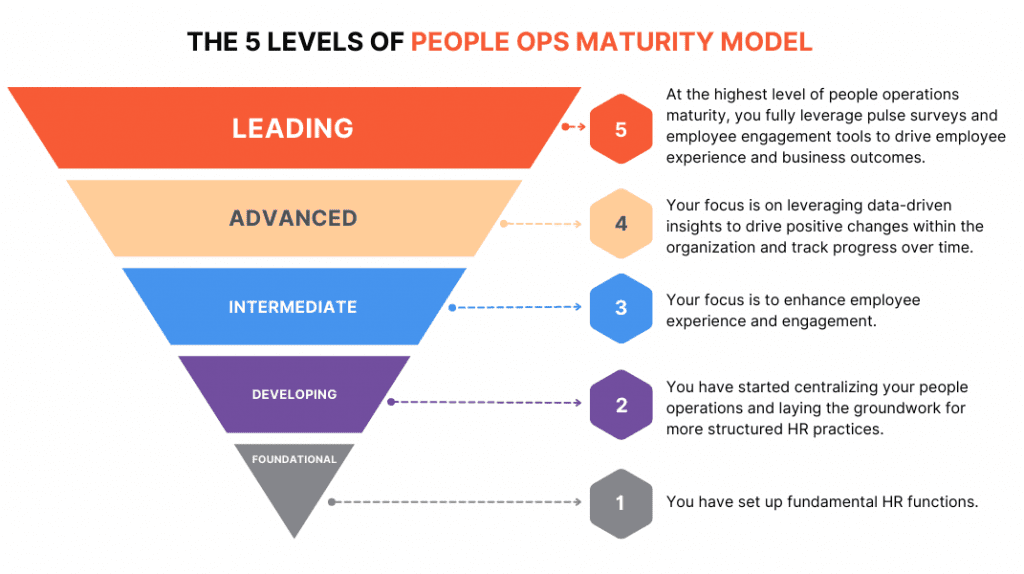
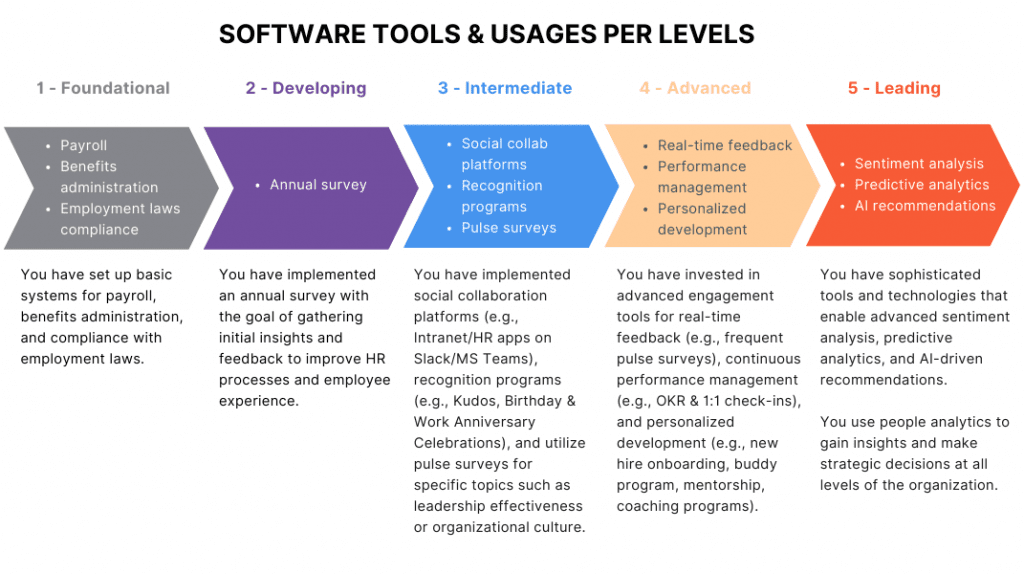
Level 1: Foundational – You have set up fundamental HR functions such as payroll, benefits administration, and compliance with employment laws.
Level 2: Developing – You have started centralizing your people operations and laying the groundwork for more structured HR practices. You have implemented an annual survey with the goal of gathering initial insights and feedback to improve HR processes and employee experience.
Level 3: Intermediate – Your focus is to enhance employee experience and engagement. You have implemented social collaboration platforms (e.g., Intranet or HR apps on Slack, Microsoft Teams), recognition programs (e.g., Kudos, Birthday & Work Anniversary Celebrations), and utilize pulse surveys for specific topics such as leadership effectiveness or organizational culture.
Level 4: Advanced – Your focus is on leveraging data-driven insights to drive positive changes within the organization and track progress over time. You have invested in advanced engagement tools for real-time feedback (e.g., frequent pulse surveys), continuous performance management (e.g., OKR & 1:1 check-ins), and personalized development (e.g., new hire onboarding, buddy program, mentorship, coaching programs).
Level 5: Leading – At the highest level of people operations maturity, you fully leverage pulse surveys and employee engagement tools to drive HR automation and employee experience and business outcomes. You have sophisticated tools and technologies that enable advanced sentiment analysis, predictive analytics, and AI-driven recommendations. You use people analytics to gain insights and make strategic decisions at all levels of the organization.
As the future of work evolves, embracing digital transformation and artificial intelligence (AI) becomes crucial in the realm of Human Resources. The 5 Levels of People Operations Management offers a strategic compass to guide your HR journey amidst these changes. From unstructured beginnings, it enables organizations to evolve towards industry-leading HR innovation, integrating AI, change management, and advanced human capital strategies.
At each level, assessing your current people management processes is critical, identifying areas for improvement, and strategically advancing towards higher maturity. This approach weaves a dynamic fabric of company culture where all stakeholders actively participate, integrating HR strategy with broader business strategies, driven by precise metrics. In doing so, it becomes easier to attract and retain top talent, propelling your organization forward in the era of digital transformation.
Embrace this HR transformation journey, redefine traditional business processes, and rewrite the rules of #PeopleSuccess. It’s time to break boundaries, conquer new frontiers, and craft an empowering narrative for your people operations. Welcome to the future of work, a world where People Operations leads the charge.
Assess Your People Analytics Level
Earlier, during our discussion on the ‘Assess Your People Management Level’ segment, we outlined the five key levels of people management. In the fifth and ultimate level, the focus was on people analytics. Now, it’s time to further explore and evaluate your organization’s proficiency level in people analytics.
People analytics or workforce analytics spans various levels, each focusing on increasingly complex aspects of employee data and yielding progressively more nuanced insights.
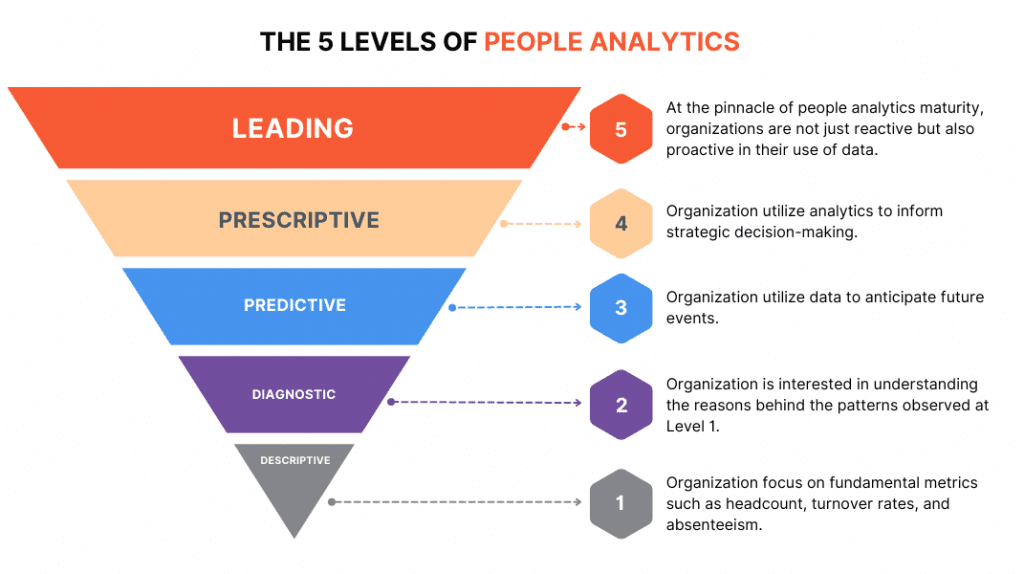
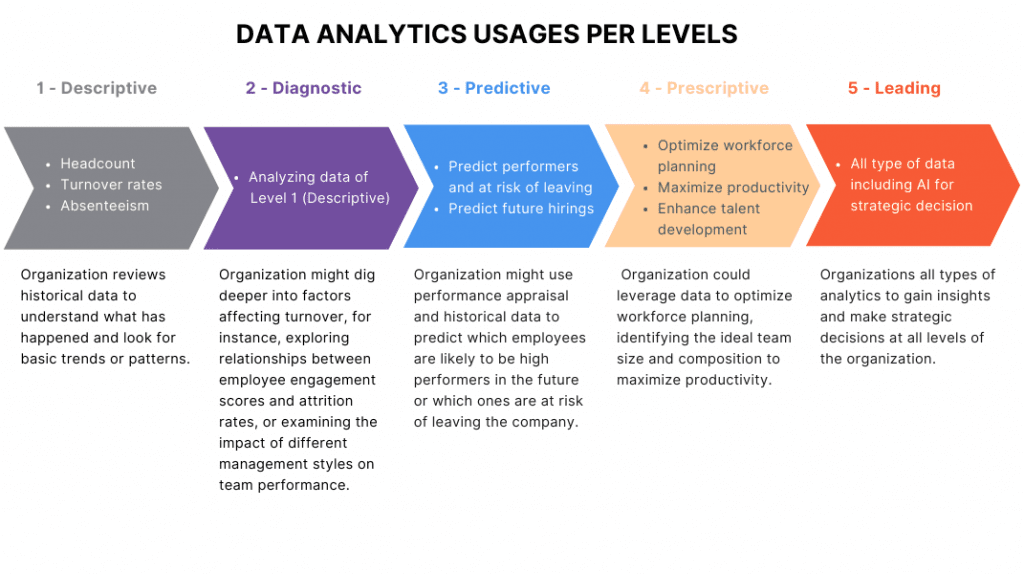 Level 1: Descriptive – Here, organizations focus on fundamental metrics such as headcount, turnover rates, and absenteeism. They review historical data to understand what has happened and look for basic trends or patterns. This level provides an overview of the workforce’s current state but doesn’t delve into the reasons behind these patterns.
Level 1: Descriptive – Here, organizations focus on fundamental metrics such as headcount, turnover rates, and absenteeism. They review historical data to understand what has happened and look for basic trends or patterns. This level provides an overview of the workforce’s current state but doesn’t delve into the reasons behind these patterns.
Level 2: Diagnostic – Companies at this level are interested in understanding the reasons behind the patterns observed at Level 1. They might dig deeper into factors affecting turnover, for instance, exploring relationships between employee engagement scores and attrition rates, or examining the impact of different management styles on team performance. Here, the data starts to inform why certain trends are occurring.
Level 3: Predictive – Organizations operating at this level utilize data to anticipate future events. They might use performance appraisal and historical data to predict which employees are likely to be high performers in the future or which ones are at risk of leaving the company. They might also forecast future hiring needs based on business growth patterns and turnover rates.
Level 4: Prescriptive – At this advanced level, analytics are utilized to inform strategic decision-making. Organizations could leverage data to optimize workforce planning, identifying the ideal team size and composition to maximize productivity. They might also use analytics to enhance talent development, pinpointing the skills and experiences that correlate with success in different roles and designing personalized development plans.
Level 5: Leading – At the pinnacle of people analytics maturity, organizations are not just reactive but also proactive in their use of data. They integrate all types of analytics to gain insights and make strategic decisions at all levels of the organization. They’re not just looking at what has happened or why, but also identifying patterns and predicting future trends to make strategic decisions. Advanced sentiment analysis is used to understand employee feelings and attitudes. Predictive analytics help anticipate future trends like attrition or skills gaps, and AI-driven recommendations inform talent development, succession planning, and workforce strategy.
In a Level 5 company, the integration of traditional org chart analysis and Organizational Network Analysis (ONA) is expected. The traditional org chart provides insights into formal hierarchies and reporting structures, while ONA reveals informal networks and patterns of collaboration. With these combined insights, organizations can strategically optimize communication, collaboration, and leadership development.
At its peak, a Level 5 company wouldn’t just be using these tools but also innovating with them. They could employ advanced machine learning techniques for highly accurate predictive models, natural language processing for nuanced sentiment analysis, and sophisticated ONA to identify potential leaders or collaboration gaps within the organization. Above all, a Level 5 organization would be fostering a data-driven culture, where analytics and insights are integral to decision-making processes across all levels.
HR Department and HR’s Role in Digital Transformation
Embarking on a successful digital transformation journey requires a well-thought-out transformation strategy. It’s not just about the implementation of the latest technologies, but a holistic shift in the way your organization operates. HR’s role in this transformation is pivotal, as the Human Resources Management (HRM) department serves as the backbone of your organization. As a bridge between the workforce and management, HR can drive this change from within, ensuring everyone is aligned and ready to adapt to new technologies and processes.
According to McKinsey research, companies with robust HR practices are more likely to achieve successful digital transformations. These organizations see the digital age as an opportunity, using it to cultivate competitive advantages and achieve their business goals. They do not limit the role of HR to traditional duties; instead, they involve HR in strategic decision-making processes, asking them to help identify potential obstacles and create solutions for smooth transitions.
Moreover, an essential aspect of a successful transformation strategy is focusing on employee retention, particularly on reducing regretted attrition. In the rapidly evolving digital landscape, maintaining a skilled, committed workforce is crucial. By focusing on people operations, organizations can ensure they’re providing a positive work environment that nurtures talent and fosters long-term loyalty. After all, people are your most significant asset, and the way you manage them can make or break your transformation efforts.
In the digital age, HR’s role is no longer just about administration; it’s about leading strategic initiatives that align human resource management with the company’s broader objectives. By adopting advanced HR strategies and technologies, organizations can not only enhance their day-to-day operations but also foster a work environment that attracts and retains top talent. Thus, HR becomes an integral part of the business strategy, playing a vital role in shaping the company’s future.
Remember, transformation is not a one-time task; it’s an ongoing process that demands consistent effort and flexibility. With the right strategy and mindset, your organization can use these challenges as stepping stones to become more efficient, resilient, and ready for whatever the future holds.
Striving for Level 5: Leading People Operations
As we reflect on this journey through the levels of People Operations Management, it’s crucial to understand the significance of aiming for Level 5: LEADing. Executive coaching emerges as a compelling tool at this stage, illuminating the path for business leaders to unlock the potential of a people-centric approach. When leaders truly understand and value the essence of people operations, it transforms the organizational culture, fostering an environment where every individual feels acknowledged, engaged, and driven to excel.
Aiming for Level 5 is not merely about reaching a certain benchmark; it’s about embracing a mindset that places employees at the heart of business operations. It is this perspective that underlines the dynamics of employee satisfaction, enabling leaders to delve deeper into what motivates their team, what their aspirations are, and how they perceive their roles. When organizations reach the LEADing level, they become adept at creating a culture that resonates with every employee, driving their productivity and fostering an environment of mutual success.
Business models at the LEADing level take a leap forward, harnessing the power of big data in human resources to move beyond conventional metrics. Traditional indicators like churn rate or DE&I quotas evolve into more nuanced understandings of why employees with certain characteristics perform the way they do. Are there issues tied to individual performance, management styles, or are the challenges rooted in the job or organizational design? The insights derived at this level empower organizations to develop targeted strategies, which not only identify problems but also offer actionable solutions to enhance individual and collective performance.
Reaching Level 5: LEADing is transformative. It signifies an organization’s maturity in integrating people operations into its strategic fabric. In such organizations, every function, every leader, and every team is aligned in creating exceptional employee experiences. It’s a state where HR teams effortlessly develop short-term and long-term KPIs and where the end-to-end employee journey is clearly defined and mapped out.
In conclusion, aiming for Level 5: LEADing is a journey of evolution and growth, a strategic decision that unlocks new levels of success. By putting people first, companies can redefine their future, creating workplaces that inspire, motivate, and empower. Remember, your people are your most significant asset, and how you engage them is a reflection of your organization’s vision and values. Embrace the era of People Operations and rewrite the rules of organizational success. The future of work is here, and it’s an exciting world where people are at the heart of everything we do.
About the Author
 Co-founder of LEAD, Yumi A. Willems, is an innovative entrepreneur and leader with a track record of constructing high-performing teams and propelling company growth. As the inaugural Country Manager for Meitu Japan, she played a pivotal role in the company’s $5 billion IPO. A regular on business TV shows and PWC’s people management panel, she leverages her extensive research in HR Management and People Analytics from Wharton School, enhanced by her interactions with hundreds of HR leaders.
Co-founder of LEAD, Yumi A. Willems, is an innovative entrepreneur and leader with a track record of constructing high-performing teams and propelling company growth. As the inaugural Country Manager for Meitu Japan, she played a pivotal role in the company’s $5 billion IPO. A regular on business TV shows and PWC’s people management panel, she leverages her extensive research in HR Management and People Analytics from Wharton School, enhanced by her interactions with hundreds of HR leaders.
The inspirations for this article are the noteworthy contributions from leading figures and organizations in the Human Resources and People Operations landscape. They include Jay Fulcher, Kevin Marasco, and Tracy Cote, whose seminal work “People Operations” has been a guiding resource. The expertise of Josh Bersin in HR technology, talent management, and leadership, and the pioneering efforts of Sjoerd Van Den Heuvel and Tanya Bondarouk in HR analytics have also significantly influenced the content of this piece.

